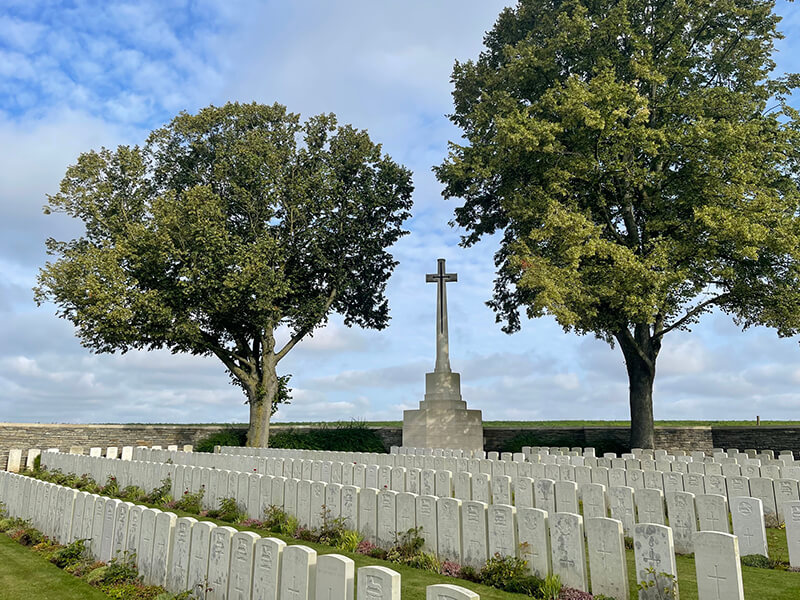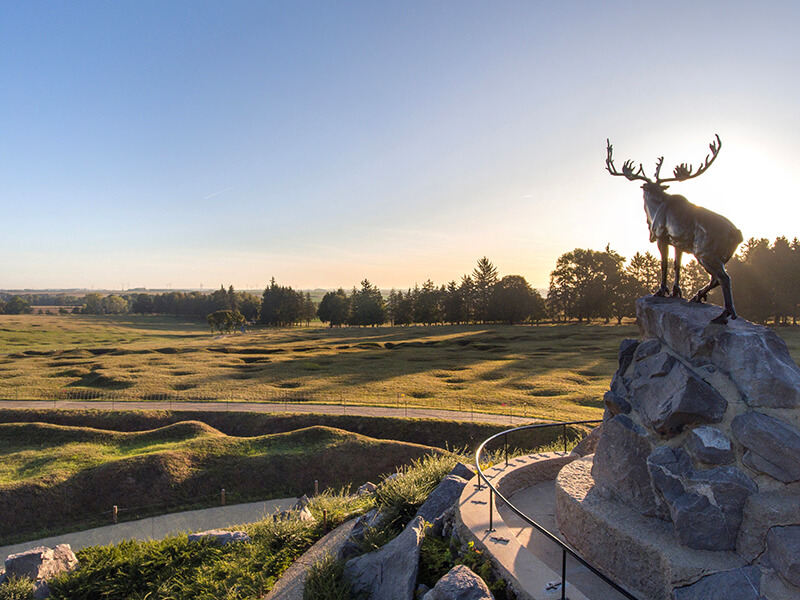28 November 2022
Somme war cemeteries and memorials to visit
The World War 1 battlefields of the Somme bore witness to some of the bloodiest fighting of anywhere on the Western Front. Discover more about our Somme war cemeteries and memorials.
Somme war facts
The Battle of the Somme 1916 was a largescale combined offensive by forces of British and French Empires against the German lines astride the river Somme, in northern France. The Battle of the Somme today is chiefly remembered for the horrors of the first day, the sacrifice of the “Pals” battalions and the grinding attrition of trench warfare.
The Battle of the Somme began on 1 July 1916 and lasted for 141 days, ending on 18 November 1916.
The first day of the Battle of the Somme is regarded as the worst in British military history, as the British Army suffered over 57,000 casualties, of whom the Commission commemorates over 18,500 who were killed.
Many of those going into battle for the first time on 1 July belonged to the so called “Pals battalions” of the British Army. Groups of volunteers, many from the same communities, workplaces, clubs, or organisations who enlisted together at the beginning of the war, served together and often all too tragically died together, leaving whole communities back home grieving for their lost loved ones.

Recruits of the 'Grimsby Chums' , later the 10th Battalion, Lincolnshire Regiment, during rifle training, September 1914. © IWM Q 53286
Despite the disaster of the first day, gains were made, and the offensive would continue for 141 days ending on 18 November 1916. An estimated 3.5 million men from all sides took part in the Battle of the Somme, with over 1 million being casualties during the four and half months of fighting.
The battle also saw major technical innovations including the first use of tanks in warfare, at the Battle of Flers-Courcelette on 15 September 1916.
How many soldiers are buried in Somme?
Close to 150,000 Commonwealth casualties are buried in close to 350 sites on the Somme. They range from large cemeteries with thousands of casualties through to small cemeteries and individual graves in village churchyards and burial grounds.
Where are Somme soldiers buried?
Cemeteries containing the graves of the fallen of the Somme can be found in a number of places across Northern France and the United Kingdom.
Men were buried where they fell in WW1 battlefield cemeteries, others were moved to larger cemeteries after the war, and some were evacuated for medical care and later died at hospital centres away from the frontlines.
Some of our largest Somme cemeteries are:
- Serre Road Cemetery No.2, 7137 casualties
- Caterpillar Valley Cemetery, Longueval, 5571 casualties
- Delville Wood Cemetery, Longueval, 5523 casualties
- London Cemetery and Extension, Longueval, 3874 casualties
- A.I.F. Burial Ground, Flers, 3647 casualties
- Ovillers Military Cemetery, 3561 casualties
Where is the memorial for the Battle of Somme?
There are eight CWGC memorials to the missing of the Battle of the Somme 1916 and to those that died on the Somme during the rest of the war:
- Thiepval Memorial, 72171 casualties
- Pozieres Memorial, 14701 casualties
- Vimy Memorial, 11151 casualties
- Villers-Bretonneux Memorial, 10703 casualties
- Neuve-Chapelle Memorial, 4653
- Caterpillar Valley (New Zealand) Memorial, 1205 casualties
- Beaumont-Hamel (Newfoundland) Memorial, 808 casualties
- Noyelles-Sur-Mer Chinese Memorial, 92 casualties
Visiting Thiepval memorial to the missing of the Somme
The Thiepval Memorial to the Missing of the Somme is the largest CWGC memorial to the missing anywhere in the world.
Designed by Sir Edwin Lutyens, the Thiepval Memorial bears the names of more than 72,000 missing officers and men of the United Kingdom and South African forces who died on the Somme before 20 March 1918, more than 90% of whom died between July and November 1916.

The memorial is also a monument to the Anglo-French alliance, recognising the joint nature of the Somme offensive as well as the wider, shared war effort. At the foot of the memorial lies the Thiepval Anglo-French Cemetery which contains equal numbers of French and Commonwealth soldiers many of whom died during the battle of the Somme.
As one of the most iconic war memorials in the world, Thiepval often plays host to remembrance services, including a regular service on 1 July each year to mark the anniversary of the first day of the Battle of the Somme.
One of the most notable events marked the 100 year anniversary of the end of World War One. The Shrouds of the Somme was a powerful piece of commemorative art where 72,000 shrouded figures (one for each of the names listed on the memorial) were made and then laid at the foot of the memorial, a tactile reminder of the sheer scale of the human sacrifice.
Can you visit the Somme battlefields of ww1?
The scars of the Great War remain on the countryside of Northern France - a stark reminder of the horrors of war and the sacrifices made by those who fought there.
The battlefield of Beaumont-Hamel is one of the best preserved examples of the Somme battlefield. Visitors today will be able to clearly see the lines of trenches and the myriad of shell craters which pox mark the landscape.
It is here that the Newfoundland Regiment made their heroic but doomed advance against overwhelming enemy fire on the first day of the Battle of the Somme, and as such it was chosen as the site for a memorial to all Newfoundlanders who lost their lives during the war.

SERRE ROAD CEMETERY No.2
Serre Road Cemetery No. 2 is the largest of three Serre Road Cemeteries. It contains more than 7,000 casualties from World War One, nearly 5,000 of whom are unidentified. The vast majority of the identified casualties are from the UK, however there are also groups of casualties from Australia, Canada, South Africa, and New Zealand, as well as a sole German casualty.
The cemetery itself was formed in May 1917 and initially held 475 casualties. It was then greatly expanded following the end of the war as casualties were found and reburied, or moved to the cemetery from smaller plots in the region.

CATERPILLAR VALLEY CEMETERY, LONGUEVAL
Caterpillar Valley, which lends its name to the nearby cemetery, was christened by British troops stationed on the front lines near Longueval village. Caterpillar Valley Cemetery contains nearly 1800 identified casualties of World War One, with a further 3,800 unidentified burials.
The majority of the casualties found here are United Kingdom forces, buried alongside Australian, South African and New Zealander troops. Of the identified troops, roughly three quarters of them fell between July and August 1916, the early months of the Battle of the Somme.
Like Serre Road, burials from plots within the region were moved to Caterpillar Valley. It also contains the Caterpillar Valley (New Zealand) Memorial which commemorates 1,200 New Zealand soldiers who have no known grave.
On 6 November 2004, the remains of an unidentified New Zealand soldier were taken from the cemetery and returned to Wellington, New Zealand, where they lay at rest within the Tomb of the Unknown Soldier at the New Zealand National War Memorial.

DELVILLE WOOD CEMETERY, LONGUEVAL
Delville Wood Cemetery takes its name from the dense forest that played host to a series of engagements during the Battle of the Somme, known as the Battle of Delville Wood.
The cemetery itself was formed after the Armistice, when remains from smaller cemeteries and isolated sites were brought together. It now contains more than 5,500 burials of World War One, the vast majority of which date from July to September 1916. More than 3,500 of the burials here are unidentified.
Opposite the cemetery stands the South African National Memorial which is the national memorial to all South Africans who fell during World War One, as well as World War Two and the Korean War.
World War One cemeteries in France and Belgium
Throughout France and Belgium there are more than 2000 cemeteries and memorials that commemorate the many World War One Commonwealth casualties. Some of these cemeteries are huge with thousands of war dead, some are individual burials in village churchyards.
There are 371 CWGC sites located in the Somme department of France, where the vast majority of the casualties of the Battle of the Somme are buried, although as there was fighting in the region throughout the war, there are also many casualties of other battles.
Casualties of the Somme are not solely buried in these cemeteries, however, as the battle extended to the north into the Pas de Calais department, such as at Gommecourt, but troops were also evacuated from the frontlines and later died of their wounds and were buried in sites close to medical centres like Etaples Military Cemetery, or were even evacuated back to the UK before dying at home.
German WW1 cemeteries on the Somme
Jeancourt Communal Cemetery Extension contains 455 burials, the majority of which are Commonwealth war graves. However, there are also nearly 170 identified German casualties, 138 of whom died during the second half of 1916, in the midst of the Battle of the Somme. Jeancourt was home to a German hospital centre. During the war, the cemetery was used by both sides depending on who was controlling the territory at any given time. Today there are nearly 500 Commonwealth casualties of the war, buried alongside the German casualties.
Roisel Communal Cemetery Extension was begun by German forces during the war. It now contains more than 1,000 graves, half of which are Commonwealth war graves, the rest are some 500 German Foreign Nationals, 190 of whom are unidentified.
Fricourt German War Cemetery is managed by the German War Grave Commission – the Volksbund Deutsche Kriegsgräberfürsorge – and is the burial place of more than 17,000 German war dead from World War One. Around 10,000 of the burials here are casualties of the Battle of the Somme and the ensuing battles, including the German Spring Offensive and the Hundred Days Offensive.
Somme war memorials to visit
The CWGC memorials to the missing on the Somme are some of our most well-known memorials of World War One.

POZIERES MEMORIAL
The fighting on the Somme was not limited to the period of the Battle of the Somme 1916, as Commonwealth troops were deployed in the region from August 1915 until the summer and autumn of 1918 when Allied forces drove back the German Army at the end of the war.
One of the major periods of fighting in the Somme came during the German Spring Offensive in 1918.
Boughed by reinforcing troops released from the eastern front following the Russian revolution and subsequent withdrawal from the war, German high command instigated a series of major attacks designed to defeat the British French Armies and force them to the negotiating table before the full might of the American military could be brought to bear on the Western Front.
The German offensive began in March 1918, with German forces initially making the largest territorial gains seen since the beginning of the war
The deepest thrust of the German offensive cut across the battlefields of the Somme, towards Amiens. It is in this territory, close to Albert, that the Poziers Memorial stands. The memorial, designed by W.H. Cowlishaw, commemorates more than 14,000 soldiers of the United Kingdom as well as 300 South African casualties, who died during the German offensive from 21 March to 7 of August 1918, by which time the Allied forces had stemmed the tide of the German advance and were themselves preparing to go on the offensive.
Those who died during the subsequent Allied counter attack known as the Hundred Days Offensive which began on 8 August at the Battle of Amiens are commemorated by the Vis-en-Artois Memorial

VILLERS-BRETONNEUX MEMORIAL
The 1918 German advance across the Somme was stopped short of Amiens at the village of Villers-Bretonneux.
Australian forces played a vital role in the two battles of Villers-Bretonneux, both in stopping the German surge towards the coast, and in the hard-won recapture of the village. Such was their levels of bravery and sacrifice, the Australian National Memorial was erected here.
As a National Memorial, the Villers-Bretonneux commemorates all Australian service people who lost their lives during the Great War, but it also acts as a memorial to the missing for more than 10,000 Australian soldiers who died in France during the First World War.
Nearby lies Villers-Bretonneux Military Cemetery which contains the graves and memorials of more than 2,140 servicemen of the British Empire including nearly 780 who served with Australian forces.

CATERPILLAR VALLEY MEMORIAL
At the end of the war, the New Zealand officials elected to build small memorials at areas of significance, rather than fewer larger memorials like the Thiepval or Vimy Memorials. Caterpillar Valley Memorial is one of seven memorials on the Western Front commemorating the New Zealand fallen of the First World War.
The Caterpillar Valley memorial commemorates just over 1,200 New Zealand war dead during the Battle of the Somme in 1916 who have no known grave.

BEAUMONT-HAMEL (NEWFOUNDLAND) MEMORIAL
The opening day of the Battle of the Somme is known as the bloodiest day in British military history, but it was also a dark day for the people of Newfoundland.
Today, the province of Newfoundland and Labrador is part of Canada. However, during World War One, it was a separate British dominion. When the war began, Newfoundland raised its own regiment, which served as part of British forces.
On the morning of the battle, the Newfoundland Regiment were to advance alongside the Essex Regiment to support the initial attack. Despite the withering fire from German defences, the Newfoundlanders continued their advance, incurring huge losses.
Of the approximately 800 men who went forward only about 110 survived unscathed, of whom only sixty eight were available for roll call the following morning. No unit suffered heavier losses that day.
Beaumont-Hamel (Newfoundland) Memorial stands among the preserved trenches of the Newfoundlanders' position. It lists the names of more than 800 servicemen of Newfoundland who have no known graves, including some 220 members of the Newfoundland Royal Naval Reserve and Mercantile Marine lost at sea.
Discover war cemeteries and memorials
You can discover more about the war cemeteries and memorials to the missing on the Somme, as well as at our sites around the world, through the Commonwealth War Graves Commission website.
You can search for all sites on the Somme and find out more about how to visit our sites as well as details about the casualties we commemorate there.
The perfect starting point when visiting the cemeteries and memorials of the Western Front.
Visit the CWGC in IeperNo trip to the Western Front would be complete without seeing our visitors centre in Arras, France.
The CWGC Visitor Centre
